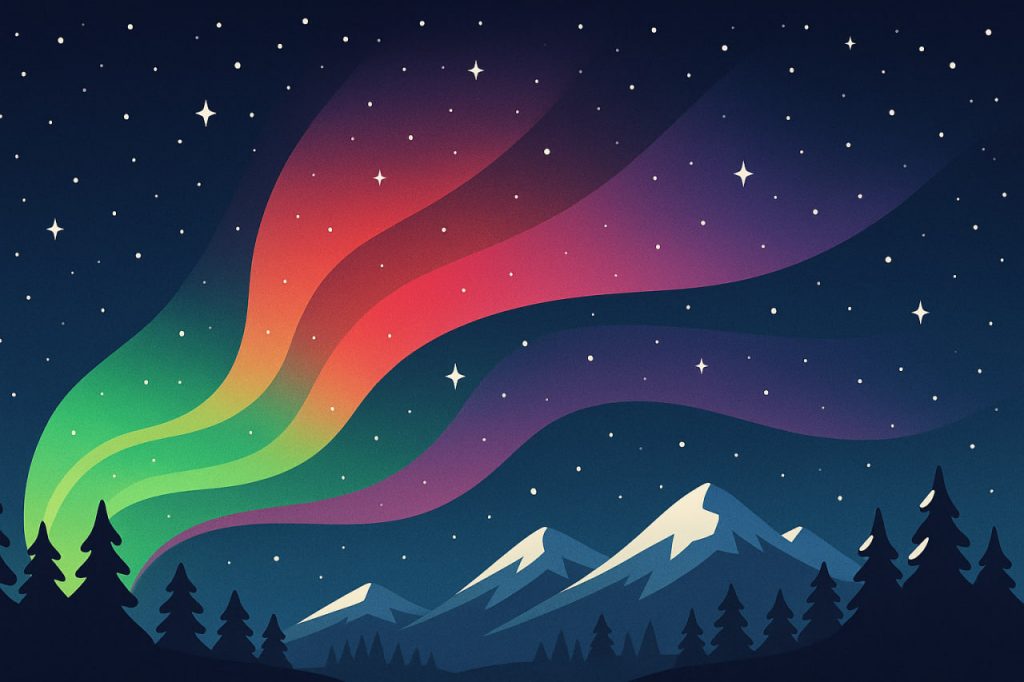The aurora, also known as the northern or southern lights, is one of the most spectacular natural phenomena on Earth. It occurs when charged particles from the Sun interact with Earth’s atmosphere, producing glowing light in the polar skies. One of the most fascinating aspects of the aurora is its variety of colors — green, red, purple, and even blue. The science behind these colors lies in the chemistry and physics of our atmosphere.
How Auroras Form
Auroras are created when the solar wind — streams of charged particles from the Sun — collides with Earth’s magnetic field. These particles are guided toward the poles, where they enter the atmosphere and interact with atoms and molecules, releasing energy in the form of light. This process is called excitation and emission.
Why Different Colors Appear
The colors of the aurora depend on which gases in the atmosphere are excited and at what altitude the interactions occur:
- Green: The most common color, caused by oxygen atoms at altitudes of about 100–300 km.
- Red: Produced by oxygen at higher altitudes (above 300 km), where collisions are less frequent.
- Blue and Purple: Caused by nitrogen molecules, often appearing at lower altitudes.
- Pink and Yellow: Mixtures of emissions from oxygen and nitrogen.
Altitude and Color Variation
The altitude at which the particles collide plays a major role:
- High altitudes (above 300 km): red auroras dominate due to thin oxygen.
- Medium altitudes (100–300 km): green is most visible.
- Low altitudes (below 100 km): purple and blue tones from nitrogen.
Why Auroras Change So Quickly
Auroras often shift colors rapidly because the solar wind is constantly changing in intensity and composition. Stronger geomagnetic storms deliver more particles, producing brighter and more varied colors.
Cultural and Scientific Importance
Throughout history, auroras inspired myths and legends, often seen as messages from gods or spirits. Today, scientists use aurora studies to understand space weather, which can affect satellites, communications, and power grids.
Conclusion
The northern and southern lights shine in different colors because of the interaction of solar particles with oxygen and nitrogen at various altitudes. Their beauty not only inspires people but also helps scientists learn more about Earth’s connection to the Sun.
Interesting Facts
The aurora’s colors come from interactions between charged solar particles and gases in Earth’s atmosphere, each emitting light at specific wavelengths. The most common green glow is produced when oxygen atoms about 100–300 km above Earth are excited by energetic electrons. At higher altitudes, oxygen can also emit a deep red light, though this is rarer because it requires weaker collisions and low atmospheric density. Nitrogen molecules add vibrant purples, pinks, and blues, depending on their energy state and whether they are ionized or neutral. Interestingly, the color patterns of an aurora depend not only on altitude but also on the speed of incoming solar particles — faster particles penetrate deeper, changing the mix of gases they strike. The result is a natural light show shaped by both physics and chemistry, turning the night sky into a living spectrum of energy released from the Sun–Earth connection.
Glossary
- Aurora – glowing lights in polar skies caused by solar particles interacting with the atmosphere.
- Solar wind – streams of charged particles released by the Sun.
- Excitation – process of energizing atoms or molecules.
- Emission – release of light energy when atoms return to normal states.
- Geomagnetic storm – disturbance in Earth’s magnetic field caused by solar activity.


